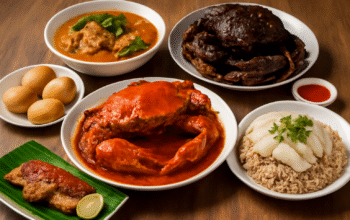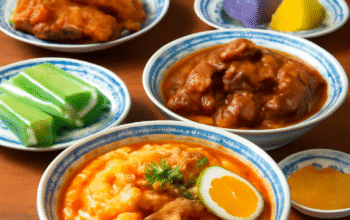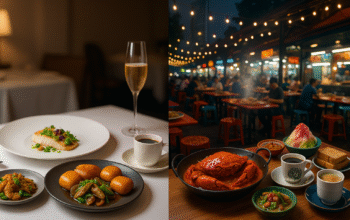Singapore’s food scene is continuously evolving, with a shift towards more innovative, dynamic, and experimental dining experiences. One of the most exciting trends in the city’s culinary evolution is the rise of fusion food and flavor innovations. As chefs experiment with blending different cooking styles, cultures, and ingredients, the food landscape of Singapore is undergoing a transformation that keeps diners on their toes.
Fusion cuisine, which blends traditional and contemporary cooking techniques from different culinary traditions, has become a key feature of modern Singaporean gastronomy. Chefs are exploring the possibilities of combining flavors from different countries, which has led to exciting and unexpected flavor pairings. A great example of this trend is the fusion of French cuisine and local Singaporean dishes. For instance, the classic French dish, ratatouille, has been reimagined by incorporating local spices such as chili padi (bird’s eye chili) or adding a touch of the tangy tamarind flavor typical in Singaporean cuisine.
Additionally, innovative chefs are introducing unconventional cooking techniques into their fusion dishes. From molecular gastronomy to sous-vide cooking, these advanced methods have opened up new possibilities for creating unique textures and flavor combinations. Local dishes like kaya toast, a beloved traditional breakfast snack, have been given a modern twist, with chefs using liquid nitrogen to freeze kaya, creating a frozen version that melts in your mouth, offering a completely new sensory experience.
As part of this trend, sustainability has also taken center stage. With a focus on using locally grown ingredients, chefs are not only supporting local farmers but also helping to preserve the region’s agricultural biodiversity. This has sparked the resurgence of traditional, locally grown ingredients such as pandan, laksa leaves, and wild ginger, which are being reimagined in creative ways to offer diners a fresh interpretation of Singapore’s culinary heritage.
Modern fusion food in Singapore goes beyond just combining flavors from different regions—it’s about elevating the dining experience as a whole. The visuals, presentation, and overall concept of each dish are meticulously crafted, with the influence of global food trends becoming evident in the plating and garnishing. With the rise of Instagram and other social media platforms, chefs are more aware than ever of the importance of aesthetics in their creations. Dishes not only need to taste good, but they also need to be visually captivating, drawing in food lovers eager to try the latest food phenomenon.
Pop-up dining and experimental restaurants are increasingly popular in Singapore, providing a platform for chefs to push the limits of creativity. These temporary dining spaces allow chefs to take risks and experiment with new ideas without the pressure of a permanent menu. The ever-changing nature of these eateries means that diners are constantly encountering new and exciting experiences.
In sum, fusion food and flavor innovation have become a defining feature of modern Singaporean cuisine. By blending traditional recipes with global influences and incorporating new technologies, chefs are redefining what it means to eat in Singapore. This new wave of culinary creativity continues to inspire food enthusiasts, making the city one of the most dynamic places in the world for food lovers.




